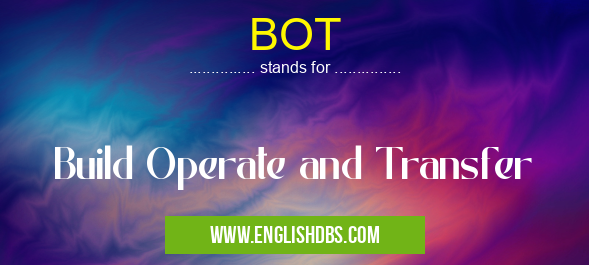What does BOT mean in GENERAL
BOT is an acronym that stands for Build Operate and Transfer. It is a form of project financing where a private sector entity receives a concession from a government or public authority to finance, design, construct, operate, and maintain a facility or infrastructure project for a specified period of time.

BOT meaning in General in Business
BOT mostly used in an acronym General in Category Business that means Build Operate and Transfer
Shorthand: BOT,
Full Form: Build Operate and Transfer
For more information of "Build Operate and Transfer", see the section below.
Meaning in BUSINESS
In the business context, BOT is a common form of public-private partnership (PPP) used to finance and develop infrastructure projects, such as roads, bridges, railways, airports, and utilities. Under a BOT agreement, the private sector entity (concessionaire) is responsible for all phases of the project, including:
- Build: Financing and constructing the facility or infrastructure.
- Operate: Managing and maintaining the facility or infrastructure for the concession period.
- Transfer: Transferring ownership and control of the facility or infrastructure back to the government or public authority at the end of the concession period.
Full Form
- B: Build
- O: Operate
- T: Transfer
Essential Questions and Answers on Build Operate and Transfer in "BUSINESS»GENERALBUS"
What is BOT (Build Operate and Transfer)?
BOT is a public-private partnership model where a private entity is contracted to design, construct, finance, operate, and maintain a public infrastructure project for a specified period, after which ownership is transferred to the government.
What are the benefits of BOT for governments?
BOT can provide governments with access to private capital and expertise, reduce the burden on public budgets, and facilitate the development of infrastructure projects that would not be possible otherwise.
What are the risks associated with BOT for governments?
BOT projects involve complex contractual arrangements and long-term commitments, which can lead to risks such as cost overruns, delays, and performance issues. It is crucial for governments to carefully assess these risks and mitigate them through well-structured agreements.
How does the "Operate" phase work in a BOT project?
During the "Operate" phase, the private entity responsible for the project assumes operational control and is responsible for maintaining and providing services for the infrastructure. This involves ensuring the efficient and safe operation of the facility, as well as adhering to agreed-upon performance standards.
What is the typical duration of a BOT contract?
The duration of BOT contracts varies depending on the nature and scale of the project. However, they typically range from 15 to 30 years, allowing the private entity sufficient time to recoup their investment and generate a profit while providing services to the public.
How is the transfer of ownership handled at the end of a BOT contract?
At the end of the contract period, ownership of the infrastructure project is transferred back to the government. This process involves a comprehensive handover, ensuring that the facility is in good condition and meets the agreed-upon standards.
Final Words: BOT is a financing and project delivery model that allows governments and public authorities to leverage private sector expertise and capital to develop and operate infrastructure projects. It provides a mechanism for sharing the risks and rewards of infrastructure development between the public and private sectors, and can help to accelerate the delivery of essential infrastructure projects.
BOT also stands for: |
|
| All stands for BOT |
